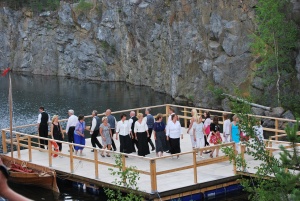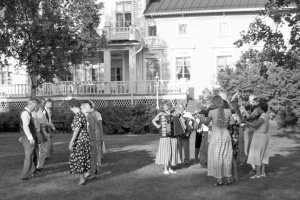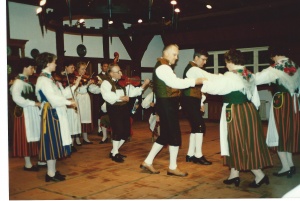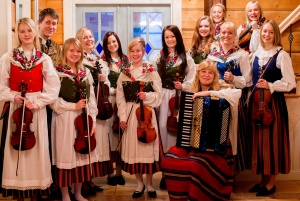The Jeppo minuet
| The Jeppo minuet | ||||
|---|---|---|---|---|
|
Practitioners and people who know the tradition well

Jeppo is a small district, located in the town of Nykarleby on the Ostrobothnian Plain. Here, folk music has been allowed to flourish in the farmhouses over the decades, resulting in the area becoming a true goldmine for those with a love of folk music. Jeppo is known for its rich minuet and polka tradition, both in Finland and internationally. The magical minuet can be experienced through both music and folk dance. The folk music has an old-timey character. It is fast, dynamic and rhythmic, characterised by shifts in pace, ornamentations and flourishes. The melodies are played by ear, so that the playing style can also be transferred to new spelmans.
Kaustinen Folk Music Festival has appointed five master spelmans from Jeppo, all originating from the village of Bärs, where spelmans can be found in all farms. Today, most songs are played in the style of Master Spelman (1971) Viktor Andersson (1901–1974). He was a wedding spelman in the early 20th century and a major personality in the spelman world. Viktor had a fiery style, and put his own stamp on the songs for generations of spelmans to come. Many of the melodies remain intact and known today thanks to Viktor. His son, Elis Andersson (b. 1926), was appointed master spelman in 1989. Elis led the spelman organisation Jeppo Bygdespelmän r.f. from its foundation in 1972. Lars Engstrand (b. 1942) played from a young age with Viktor, Elis and his father Bertel, and was appointed master spelman in 2006. Christine Julin-Häggman (b. 1961) became master spelman in 2011. In 1994, she established the folk music group Jepokryddona. Today, there are several children’s and youth groups. Dan Lillas (b. 1942) became master spelman in 2012. His father and grandfather were also violinists, and Dan teaches Jeppo songs in his spelman club.

Today, Jeppo Bygdespelmän are playing actively and attracting new members. Jepokryddona have brought music from Jeppo and the Jeppo minuet to the USA, Canada, Australia, Russia and a whole array of European countries. Younger spelman groups include Kryddona, Minikryddona and Kryddmix. Today, there are over a hundred dancers who have mastered the Jeppo minuet, including people who live in the area, spelmans, and children’s and young people’s groups. Nowadays, folk music and the minuet dance bear the hallmarks of a movement that has grown year on year – thanks to growing interest amongst children and young people in the Jeppo tradition.
Practising of the tradition
A Jeppo spelman is known for playing fast strokes, resembling a sewing machine when in full swing. This is entirely natural, as the second part of the minuet is danced with skipping steps. Folk music in Jeppo has a very local, distinctive feel, and many of the songs played in Jeppo cannot be heard anywhere else. The songs pass from one spelman to another by ear, ensuring the playing style is preserved. Their repertoires are very comprehensive, and the minuets are the most important elements. Many a spelman harbours a dream of having time to learn to play all the Jeppo songs during their lifetime. They feel that the minuets, often referred to as ‘minetter’ in old recordings, sound ancient and are ‘chatty’ in character. Those playing them add emphasis, take pauses, explain – perhaps sounding as if they are bragging, or are driving the music forward, irritated. Dotted notes, trills and flourishes are common and shifts in pace are another standard feature. There are some similarities with baroque music. Minuets and polskas in Gregorian modes are common, and to a normal ear the melodies are peculiar or even downright strange, which makes them fun and interesting to play. There are still parts of the vast repertoire that have not yet been recorded as sheet music. Sheet music is only used to remind the player what to play. Other dances and melodies include the Jeposmetton cook’s dance, wedding music, waltzes, polkas, schottisches, mazurkas and jigs.
A minuet dance comprises a minuet in 3/4 time, followed immediately after by a polska. The Jeppo polska exists in both two-time and three-time formats. The minuet is a couples’ dance – the men stand in one row opposite the women’s row. There are no folk dance groups in Jeppo, instead people learn by copying the older dancers. People out in the countryside who learnt as children can easily join the row of dancers at the ‘end of the table’, can lead the couples, and can show when to come together and when to stamp. The male dancer also decides the length of the minuet. The first part of the minuet is calm and the dancers move in a dignified way, directing their attention towards their partner in the other row. After the ‘coming together’ in the middle of the dance, the speed increases and the dancers skip the basic steps at a fast pace. Most often, one of the men will make a spirited call, or ‘hujkar’, energising the dancers and audience. Spelmans will play the polska for as long as there are dancers to dance it. Usually, two couples will dance together in a ring, however, the dance can also work with one or three couples. Immediately after the polska, thanks are exchanged for the dance.
Today, the minuet is danced at weddings, festivals, national heritage celebrations and parties. The minuet has always been performed as part of Jepokryddona’s tours around the world. It is important that the minuet melodies and dance are not allowed to drift apart from each other. For this reason, Jeppo natives make an effort to be able to dance the minuet to all the old minuet melodies – as people have done for centuries.
The background and history of the tradition
The minuet originates from Poitou in south west France, and the folk dance was first mentioned during the 17th century. The ‘Sun King’ Louis XIV grew extraordinarily fond of the dance, introducing it in Versailles. The minuet became an elegant court dance that spread to courts around Europe. The dance spread to the Nordic countries and the minuet became popular in Finland. The Walloons were also significant in the spread of the dance when they came to Finland, via Sweden, for the iron works. Ostrobothnia is the only place in Finland where the minuet tradition has survived to this day. The minuet became the dance of the resident population. The poet and author Zacharias Topelius (1818–1898), born in Nykarleby, could dance the minuet and wrote about the dance in his books. Our national poet, Johan Ludvig Runeberg, from Jakobstad, released the poem Älgskyttarne (‘Elk hunters’) in 1832, featuring a description of the minuet dance in Ruovesi. However, the minuet began to disappear and was replaced by more modern dances in most parts of the country.

In Jeppo, the minuet took on the role of a ceremonial dance and the most important dance at weddings. Weddings would often last three days, with two spelmans playing. In Jeppo, it is said that the priest started the wedding dance with the bride. After that, over 20 minuets were danced one after the other, where the bride danced with the groom and the couple’s closest friends, who had followed the couple up to the alter during the ceremony. The first dances were slow and elegant, but the longer the wedding went on, the faster the minuets became. In Jeppo, it is common for the second part of the minuet to be danced in a skipping fashion. It involves more verve, shouts, stamps and claps. Carl Michael Bellman (1740–1795) described the same phenomenon in Stockholm in his epistle No 9, explaining how people danced and skipped the minuet. Eventually it became more common, even in Jeppo, for the newlyweds to dance the first dance together, and the following dances with friends and parents. Right up until the 1950s the minuet was a common part of weddings in the area. Over the last 50 years the minuet has been danced at weddings, provided there was a spelman who had mastered the dance melody, and enough wedding guests who knew the dance.
Petri Hoppu PhD researched the Jeppo minuet at the end of the 1990s, stating that there were clear similarities with the minuet danced at Louis XIV’s court.
In 1985, the Jeppo spelmans and dancers received the Europa Prize for Folk Art from Stiftung F.V.S. in Germany for their outstanding musical achievements and significant efforts in the preservation of folk dance and music life in Swedish-speaking Finland.
The transmission of the tradition
The Jeppo tradition is being passed on every week via Jepokryddona, an independent group, and Jeppo Bygdespelmän, who play at the Nykarleby workers institute. The youngest spelmans and dancers work within the Music Institute of the Jakobstad Region. The groups perform regularly at concerts, parties, weddings, festivals and a range of other events. Spelmans regularly organise minuet dance practice sessions for both experienced dancers and newer dancers wishing to learn. Through projects such as the Swedish Cultural Foundation in Finland’s ‘Kultur i skolan’ (‘Culture in school’), primary-level pupils in Nykarleby are given the chance to learn about Jeppo’s folk music and dance. Experienced minuet dancers visit a school and the pupils learn by copying their steps. The school pupils then perform the minuet at a school party. The pupils learn the melodies by ear. School concerts are given every year.
Jepokryddona record new CDs, primarily featuring songs that have not yet been documented on disc. Jepokryddona made a music video featuring people of all ages, from children and young people upwards, in 2015 to the song Itt en enda moldont (Remix) (‘Not a single cloud (Remix)’). The project drew the public’s attention to folk music as a happy, youthful style of music. Jeppo folk music is played at camp programmes for children and young people. Thanks to contacts in Sweden, Jeppo songs are played in cooperation with the Bilda study association in Gävleborg County. Collaboration through the Leader project is leading to cooperation with several other European countries.
The future of the tradition
Interest in Jeppo’s folk music has grown over the years, and is now something of a folk movement. Hard work every week ensures that many groups play the old songs. Participants span a wide age spectrum, from six years old all the way to pensioners. The people of Jeppo have always taken it for granted that the minuet would be danced and played in the area, however, times change and today concentrated efforts are required to awaken interest in old traditions. In the future we would love to establish a ‘Jeppo academy’ with the aim of supporting folk music and the minuet dance in Jeppo. The objective would be to teach the minuet to learners old and young, learn new songs, release music, make music videos, collect dance and spelman photographs, provide sheet music for Jeppo songs, organise courses on Jeppo songs and the Jeppo minuet, organise regular dance and playing trips to cottages, perform at festivals and events, work together at seminars on folk music, create a melody bank of Jeppo songs, and carry out international promotional activities, including tours. During the holidays, people returning to Jeppo from elsewhere happily participate in dance courses, making it easy for them to practice or learn by copying the minuet steps from experienced dancers.

All the material could be organised by a cultural centre. Much of this work is already underway, but it could be organised into a better entity for the future. The most important collaboration partner for the Jeppo tradition is the Finland-Swedish Folk Music Institute, which has supported the tradition for many years.
Cooperation with workers institutes, cultural and recreational units within city organisations, adult education colleges, the Church, folk music institutes, the Society of Swedish Literature in Finland, spelman associations, the Swedish Cultural Foundation, local youth and rural culture societies, village councils and schools in the area are key. Jakobstad Music School with the Music Institute of the Jakobstad Region, YA! Vocational College of Ostrobothnia and Novia University of Applied Sciences all have students interested in folk music. Cooperation and exchange with other song workshops in the Nordic region are inspirational for our young folk musicians.
The community/communities behind this submission.
Jeppo Bygdespelmän r.f., Jepokryddona samt menuettdansarna
Mästerspelman Lars Engstrand, Vörå (Jeppo), Mästerspelman, musikmagister Christine Julin-Häggman, Jeppo Staden Nykarleby, stadsdirektör Gösta Willman Fil. dr Gunnel Biskop, Helsingfors Ordförande för Folkmusiksällskapet, Fil. dr Cecilia Björk, Vasa Docent i dansforskning Petri Hoppu, Tammerfors Professor Ann-Mari Häggman, Vasa
Jeppo Hembygdsförening r.f. Jeppo Marthaförening r.f. Jeppo Ungdomsförening r.f. Jeppo Ungdomsorkesterförening r.f.
Bibliography and links to external sources of information
Videos
Jeppobor dansar sin menuett 1997.
Recordings
Jepokryddona 2000. FMI CD 19.
Jepokryddona 2004. "Åotråolit råolit", FMI CD 22.
Jeppo Spelmän. Finlandssvensk folkmusik 6, LRLP 153, Love Records. Lp-skivan.
Jeppolåtar efter Viktor Andersson 1901-1974. Lp-skivan med texter.
Mestaripelimannit RCA INTS 1324/2. Lp-skivan.
Literature
Biskop, Gunnel 2015. Menuetten – älsklingsdansen. Om menuetten i Norden – särskilt i Finlands svenskbygder – under trehundrafemtio år. Helsingfors: Finlands Svenska Folkdansring.
Hoppu, Petri 1999. Symbolien ja sanattomuuden tanssi. Menuetti Suomessa 1700-luvulta nykyaikaan. Helsinki: Suomalaisen Kirjallisuuden Seura.
Julin-Häggman, Christine 1996. Folk och Musik. I Spelman och musiker – en balansgång mellan traditionellt och klassiskt. Vasa: Finlands Svenska folkmusikinstitut, 159–168.
Kolehmainen, Ilkka (toim.) 1992. Mestaripelimannit. Kauhava: Kansanmusiikki-instituutin julkaisuja 33.
